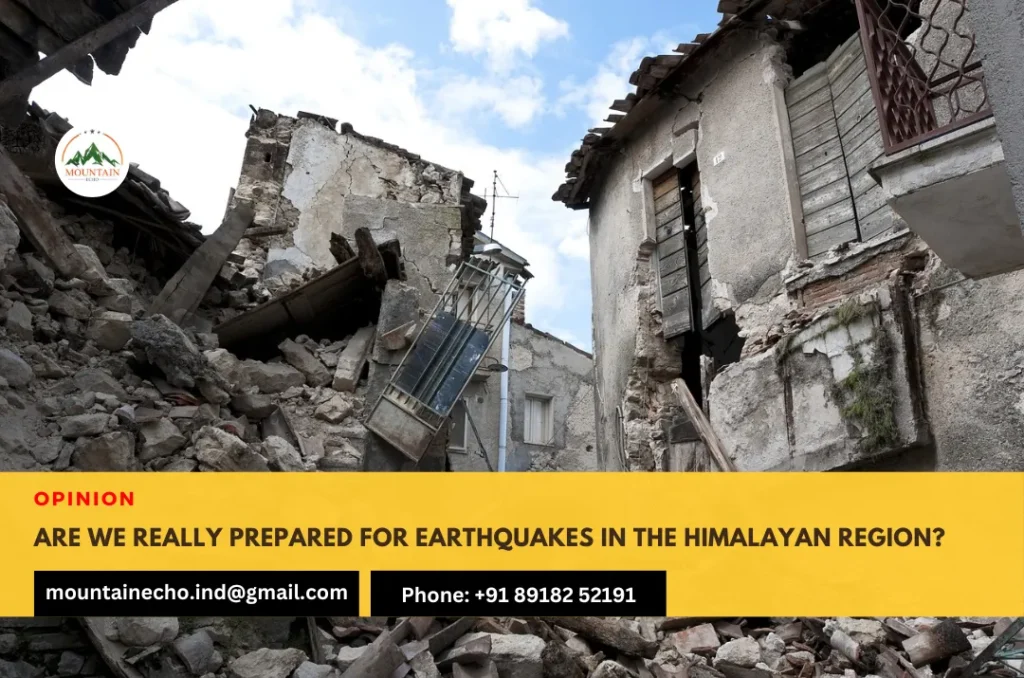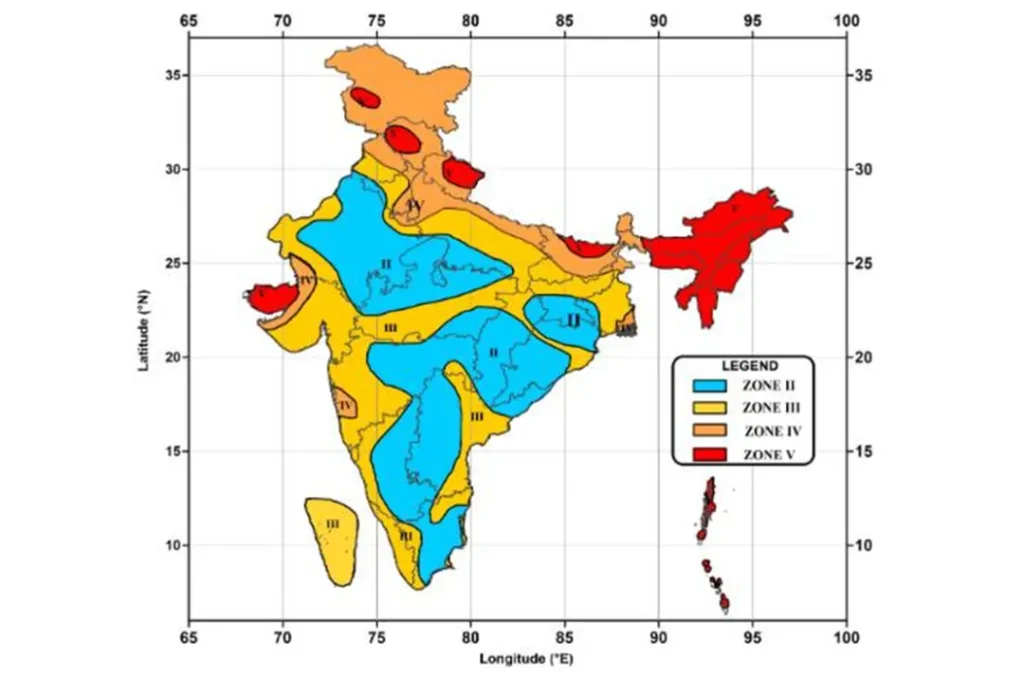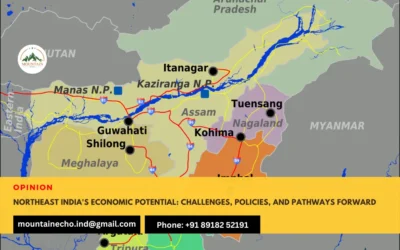Are we really prepared for earthquakes in the Himalayan region?
The Himalayan region, which falls under the Seismic Zone IV and V, is a tectonically active region and the region has experienced strong earthquakes several times. The convergence of the Indian and Eurasian plates in the Himalayan region creates two subduction zones, making it seismically active.
Mountain Echo now has WhatsApp Channel. Please join us there.
Research shows that over 59% of India’s landmass is prone to earthquakes and falls under various seismic zones. Within India, the Himalayan regions are at high risk of seismic activities and are prone to earthquakes.
 Increasing Seismic Activities
Increasing Seismic Activities
For over 700 years, the region has been under tectonic stress and enough strains have been accumulated to trigger strong earthquakes that can have a serious impact on the lives of millions.
Over the past three decades, there has been an increase in earthquake frequency, indicating continuous tectonic activity. A study of seismic activities in the Himalayan region shows a sharp spike in the frequency of earthquakes after 2000. Data from 1960-70 shows about 100 earthquakes per year in the Himalayan region, but after 2000, the frequency has gone up to 500-600 earthquakes of varying intensity.
Some of the most devastating earthquakes in the Himalayan region and India over the past 150 years are:
- 1897 (Shillong) – 8.0 magnitude, more than 1500 people dead
- 1905 (Kangra) – 7.8 magnitude, more than 20000 people dead
- 1934 (Nepal) – 8.0 magnitude, between 6000 – 10000 people dead
- 1935 (Quetta) – 7.7 magnitude, between 30,000–60,000 people dead
- 1950 (Assam) – 8.6 magnitude, between 1500 – 3000 people dead
- 1991 Uttarkashi – 6.8 magnitude, about 2000 people dead
- 1993 (Latur) – 6.2 magnitude, over 9000 people dead
- 2001 (Gujarat) – 7.7 magnitude, about 20000 people dead
- 2005 (Kashmir) – 7.6 magnitude, about 88000 people dead
- 2011 (Sikkim) – 6.9 magnitude, over 100 people dead
- 2015 (Nepal) – 7.8 magnitude, about 10000 people dead
- 2023 (Nepal) – about 6.0 magnitude, over 150 people dead
Apart from the loss of lives, the earthquakes have caused huge loss of properties, and in many cases, triggered other natural disasters like landslides, rockfalls, liquefaction, fires, flooding, and glacial lake outbursts.
Natural disasters, such as earthquakes, present unforeseen challenges, testing our preparedness in ways often overlooked. In any natural disaster, emergency services get overwhelmed and are often unable to respond effectively during such events.
Despite all warnings and red flags by scientists, the April 25, 2015 earthquake in Nepal caught experts and inhabitants off guard, revealing a lack of adequate preparation. The very recent earthquake of Nov 3, 2023, in Nepal, destroyed 11,000 houses, affected around 14,000 families and caused 157 fatalities.
Understanding our preparedness
Situated in a high-risk zone, the Himalayan region, including the Northeast states, faces the potential for a significant human disaster with even a moderate to heavy tremor. Earthquakes can occur anytime, regardless of the season, and there is no universal estimate for the damage they may cause.
Effective emergency planning involves mitigating potential earthquake damage through preventive measures and precautionary actions. The unpredictable nature of earthquakes necessitates a focus on proactive strategies.
Historically, our disaster response efforts are primarily centred on immediate rescue and relief efforts and lack comprehensive action plans. Despite the existing laws and regulations related to disaster management, the implementation of the rules is sporadic and lacks coordination.
It is important to integrate disaster management regulations into sustainable, equitable development cooperation to avoid the inevitability of future humanitarian crises. Assessment of earthquake vulnerability in urban areas, ranging from evaluating the physical condition and criteria of buildings to more comprehensive approaches that consider factors like population and accessibility.
Vulnerability assessment plays a crucial role in understanding susceptibility to earthquake damage and associated losses. Populated areas, particularly urban ones, face higher potential damages, and vulnerability assessment must consider both time and space due to the dynamic distribution of the population.
Natural Disasters and the Human Role
Unplanned urbanisation increases earthquake risk by concentrating populations, buildings, and assets. Sporadic constructions have resulted in congested, non-earthquake-proof concrete jungles, with 80% of buildings at risk of collapse during a magnitude 7 earthquake.
The earthquake-prone Himalayan region faces risks from insufficient design, construction quality, supervision, and building code compliance. Neglecting fire safety measures during construction makes high-rise buildings especially vulnerable to fires post-earthquake.
The impact of earthquakes also extends to critical infrastructure like highways, flyovers, bridges and dams each requiring specific preparations for earthquake resilience. The developmental aspect of these infrastructures necessitates individualised approaches to enable them to withstand seismic activities.
Developing a Disaster Preparedness Plan
Preparedness, as defined by the UNDRR, involves the knowledge and capacities developed by governments, organisations, communities, and individuals to effectively anticipate, respond to, and recover from the impacts of potential disasters. It is not a static state but an ongoing process that requires engagement.
Preparedness encompasses various elements, including contingency planning, equipment and supplies storage, coordination development, evacuation and communication plans, and training through field drills.
Public education about the use of technology plays a major role in effective earthquake preparedness. The public must know about the types of technology that can be employed to ensure the inclusion of individuals in preparedness efforts.
To develop effective earthquake preparedness measures, the government should focus on implementing expert recommendations, and organise awareness campaigns and practical training. This involves regular drills in various settings, retrofitting risky buildings and enforcing safety technologies in new constructions.
Enforcing strict construction practices, the use of quality materials, and the accountability of professionals should be mandatory. Ensuring safe emergency assistance accessibility, and requiring emergency equipment installation in all houses are additional measures to better prepare the population.
Government consultation with local and international experts is necessary to formulate and implement a strategy aimed at minimising casualties in the event of a major earthquake.
Public awareness campaigns, communication efforts, and dissemination of up-to-date earthquake safety information through various channels, including workshops, seminars, and educational curricula are essential.
The responsibility for disseminating knowledge on earthquake preparedness must be made compulsory to academic institutions, companies, healthcare organisations, media outlets and community leaders.
The government must also prepare for capacity-building for prompt response, rescue, and evacuation operations, along with hospital treatment facilities. Volunteers and the Fire Service need ongoing training and sophisticated equipment.
Despite challenges, investing in disaster preparedness is crucial, as current spending tends to focus more on post-disaster relief. It is usually seen that the government spends a major portion of expenses after disasters have occurred.
Strengthening pre-disaster emergency responses not only reduces human casualties, it also contributes to sustainable post-event development.
The preparedness of communities and households in self-rescue efforts before external assistance arrives can be a determining factor between survival and death. Household preparedness is an important factor in individual and community efforts, focusing on responsibilities and the ability to reduce risks and damage.
Despite being a disaster-prone region, there is a lack of awareness about household preparedness in response to emergencies. This involves stockpiling emergency supplies like food and water, extra batteries, battery-powered radios, battery-operated torches, first-aid kits, gas masks, helmets, fire extinguishers, escape ropes, whistles and actions like planning for exit routes and shelters, having a household evacuation plan, acquiring accident insurance.
Inclusive Preparedness Plan
The impact of earthquakes on persons with disabilities requires the formulation of policies that will enhance the resilience of vulnerable groups during and after disasters.
As of now, most of the infrastructure in the region does not have a disability-inclusive disaster plan. In such a situation, most of the persons with disability give up escaping due to fear, isolation, and a high degree of pessimism, as well as a sense of helplessness.
It is necessary to address the issue of the absence of an evacuation system for persons with disabilities; the absence of disability-inclusive disaster information; and the absence of disability-inclusive disaster prevention drills and education.
Disability-inclusive disaster management could start with the local citizens’ support and through communication between public welfare departments of the government. Government agencies need formal and informal interactions with society and organise inclusive disaster educational programs and training to ensure that persons with disability do not remain helpless during disasters like earthquakes.
The Himalayan region and the Northeast states of India, prone to frequent and intense earthquakes, face a critical need for enhanced earthquake preparedness. Increasing seismic activities in the region demand a shift from reactive to proactive strategies, focusing on comprehensive disaster management regulations, vulnerability assessments and inclusive planning. With historical tragedies underscoring the region’s vulnerability, urgent measures such as strict construction norms, public education and capacity-building programs are imperative. The emphasis on household preparedness, particularly for vulnerable groups, necessitates the importance of a holistic and inclusive approach to minimise casualties and promote sustainable post-event development.
[The article is written by Ranjeet Luitel and first published on East Mojo on November 22, 2023]

 Increasing Seismic Activities
Increasing Seismic Activities
